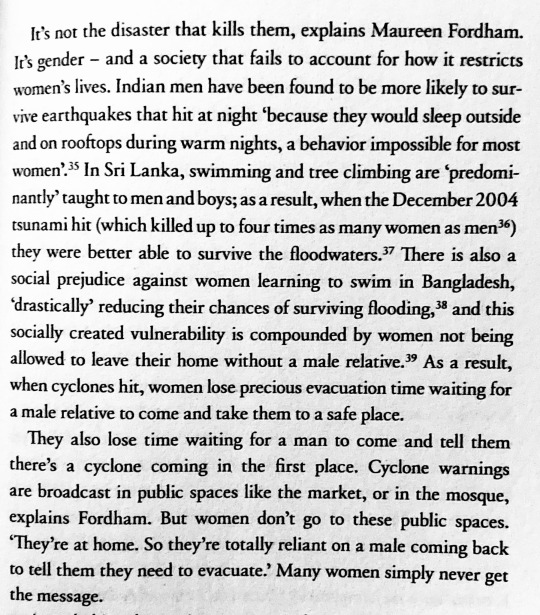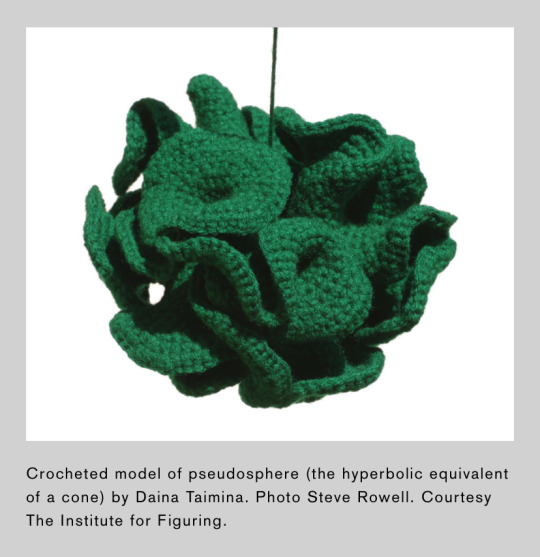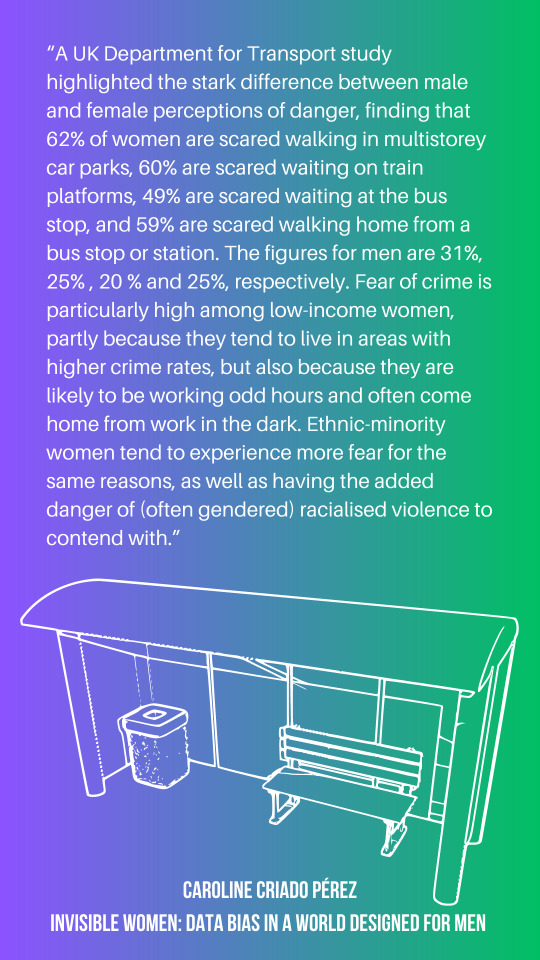#caroline criado-perez
Quote
The result of this deeply male-dominated culture is that the male experience, the male perspective, has come to be seen as universal, while the female experience--that of half the global population, after all--is seen as, well, niche.
#Caroline Criado-Perez (Invisible Women)
173 notes
·
View notes
Text
No medical terminology should be "gender as in personality"-based.
Within jurisdictions using traditional and command economic systems, disinclusion from services primarily concerns the percentage of taxes allotted to medical care.
Within jurisdictions using market economic systems, disinclusion from services primarily concerns insurance companies' cost-efficiency.
Neither the state nor private entities should be trusted to act in any such way that implicates higher expenditure versus cost-efficiency.
Erasure and miscommunication are weapons of cost-efficiency.
Standardization and use of non-sexed medical terminology is often obscuring in non-naturalized, multilingual contexts. Standardization and use of non-sexed medical terminology poses intensified threat to females and trans-identified individuals.
#medical terminology#invisible women#caroline criado-perez#queer theory#female erasure#trans erasure#radical feminist community#mine
8 notes
·
View notes
Quote
The result of this deeply male-dominated culture is that the male experience, the male perspective, has come to be seen as universal, while the female experience--that of half the global population, after all--is seen as, well, niche.
#Caroline Criado-Perez (Invisible Women)
72 notes
·
View notes
Quote
The result of this deeply male-dominated culture is that the male experience, the male perspective, has come to be seen as universal, while the female experience--that of half the global population, after all--is seen as, well, niche.
#Caroline Criado-Perez (Invisible Women)
30 notes
·
View notes
Quote
There is no such thing as a woman who doesn’t work. There is only a woman who isn’t paid for her work.
#Caroline Criado-Perez (Invisible Women)
3 notes
·
View notes
Quote
The result of this deeply male-dominated culture is that the male experience, the male perspective, has come to be seen as universal, while the female experience--that of half the global population, after all--is seen as, well, niche.
#Caroline Criado-Perez (Invisible Women)
0 notes
Text

Caroline Criado Perez, Invisible Women (2019)
446 notes
·
View notes
Text
It took about two hours for Daina Taimina to find the solution that had eluded mathematicians for over a century. It was 1997, and the Latvian mathematician was participating in a geometry workshop at Cornell University. David Henderson, the professor leading the workshop, was modelling a hyperbolic plane constructed out of thin, circular strips of paper taped together. 'It was disgusting,' laughed Taimina in an interview.
A hyperbolic plane is 'the geometric opposite' of a sphere, explains Henderson in an interview with arts and culture magazine Cabinet. 'On a sphere, the surface curves in on itself and is closed. A hyperbolic plane is a surface in which the space curves away from itself at every point.' It exists in nature in ruffled lettuce leaves, in coral leaf, in sea slugs, in cancer cells. Hyperbolic geometry is used by statisticians when they work with multidimensional data, by Pixar animators when they want to simulate realistic cloth, by auto-industry engineers to design aerodynamic cars, by acoustic engineers to design concert halls. It's the foundation of the theory of relativity, and thus the closest thing we have to an understanding of the shape of the universe. In short, hyperbolic space is a pretty big deal.
But for thousands of years, hyperbolic space didn't exist. At least it didn't according to mathematicians, who believed that there were only two types of space: Euclidean, or flat space, like a table, and spherical space, like a ball. In the nineteenth century, hyperbolic space was discovered - but only in principle. And although mathematicians tried for over a century to find a way to successfully represent this space physically, no one managed it - until Taimina attended that workshop at Cornell. Because as well as being a professor of mathematics, Taimina also liked to crochet.
Taimina learnt to crochet as a schoolgirl. Growing up in Latvia, part of the former Soviet Union, 'you fix your own car, you fix your own faucet - anything', she explains. 'When I was growing up, knitting or any other handiwork meant you could make a dress or a sweater different from everybody else's.' But while she had always seen patterns and algorithms in knitting and crochet, Taimina had never connected this traditional, domestic, feminine skill with her professional work in maths. Until that workshop in 1997. When she saw the battered paper approximation Henderson was using to explain hyperbolic space, she realised: I can make this out of crochet.
And so that's what she did. She spent her summer 'crocheting a classroom set of hyperbolic forms' by the swimming pool. 'People walked by, and they asked me, "What are you doing?" And I answered, "Oh, I'm crocheting the hyperbolic plane."' She has now created hundreds of models and explains that in the process of making them 'you get a very concrete sense of the space expanding exponentially. The first rows take no time but the later rows can take literally hours, they have so many stitches. You get a visceral sense of what "hyperbolic" really means.' Just looking at her models did the same for others: in an interview with the New York Times Taimina recalled a professor who had taught hyperbolic space for years seeing one and saying, 'Oh, so that's how they look.' Now her creations are the standard model for explaining hyperbolic space.

-Caroline Criado Perez, Invisible Women
Photo credit
#caroline criado perez#Daina Taimina#women in stem#women’s history#women in science#crochet#crocheting#female mathematicians#hyperbolic space
270 notes
·
View notes
Text

386 notes
·
View notes
Text
Even something as basic as advice on how to exercise to keep disease at bay is based on male-biased research. If you run a general search for whether resistance training is good for reducing heart disease, you’ll come across a series of papers warning against resistance training if you have high blood pressure. This is in large part because of the concerns that it doesn’t have as beneficial an effect on lowering blood pressure as aerobic exercise, and also because it causes an increase in artery stiffness.
Which is all true. In men. Who, as ever, form the majority of research participants. The research that has been done on women suggests that this advice is not gender-neutral. A 2008 paper, for example, found that not only does resistance training lower blood pressure to a greater extent in women, women don’t suffer from the same increase in artery stiffness. And this matters, because as women get older, their blood pressure gets higher compared to men of the same age, and elevated blood pressure is more directly linked to cardiovascular mortality in women than in men. In fact, the risk of death from coronary artery disease for women is twice that for men for every 20 mm Hg increase in blood pressure above normal levels. It also matters because commonly used antihypertensive drugs have been shown to be less beneficial in lowering blood pressure in women than in men.
So to sum up: for women, the blood-pressure drugs (developed using male subjects) don’t work as effectively, but resistance training just might do the trick. Except we haven’t known that because all the studies have been done on men. And this is before we account for the benefits to women in doing resistance training to counteract osteopenia and osteoporosis, both of which they are at high risk for post-menopause.Other male-biased advice includes the recommendation for diabetics to do high-intensity interval training; it doesn’t really help female diabetics (we don’t really know why, but this is possibly because women burn fat more than carbs during exercise). We know very little about how women respond to concussions, ‘even though women suffer from concussions at higher rates than men and take longer to recover in comparable sports’. Isometric exercises fatigue women less (which is relevant for post-injury rehabilitation) because men and women have different ratios of types of muscle fibre, but we have ‘a limited understanding of the differences’ because there are ‘an inadequate number of published studies’.
— Caroline Criado Perez, Invisible Women: Exposing Data Bias in a World Designed for Men
#caroline criado perez#invisible women#invisible women: exposing data bias in a world designed for men
1K notes
·
View notes
Quote
The result of this deeply male-dominated culture is that the male experience, the male perspective, has come to be seen as universal, while the female experience--that of half the global population, after all--is seen as, well, niche.
#Caroline Criado-Perez (Invisible Women)
11 notes
·
View notes
Text
Invisible Women: Exposing Data Bias in a World Designed for Men (Caroline Criado-Perez, 2019)
"The good news is that this kind of male bias can be designed out and some of the data collection has already been done.
In the mid-1990s, research by local officials in Vienna found that from the age of ten, girls’ presence in parks and public playgrounds ‘decreases significantly’.
But rather than simply shrugging their shoulders and deciding that the girls just needed to toughen up, city officials wondered if there was something wrong with the design of parks.
And so they planned some pilot projects, and they started to collect data. What they found was revealing.
It turned out that single large open spaces were the problem, because these forced girls to compete with the boys for space.
And girls didn’t have the confidence to compete with the boys (that’s social conditioning for you) so they tended to just let the boys have the space.
But when they subdivided the parks into smaller areas, the female drop-off was reversed.
They also addressed the parks’ sports facilities.
Originally these spaces were encased by wire fencing on all sides, with only a single entrance area – around which groups of boys would congregate. And the girls, unwilling to run the gauntlet, simply weren’t going in.
Enter, stage right, Vienna’s very own Leslie Knope, Claudia Prinz-
Brandenburg, with a simple proposal: more and wider entrances.
And like the grassy spaces, they also subdivided the sports courts. Formal sports like basketball were still provided for, but there was also now space for more informal activities – which girls are more likely to engage in.
These were all subtle changes – but they worked. A year later, not only were there more girls in the park, the number of ‘informal activities’ had increased.
And now all new parks in Vienna are designed along the same lines.
The city of Malmö, Sweden, discovered a similar male bias in the way they’d traditionally been planning ‘youth’ urban regeneration.
The usual procedure was to create spaces for skating, climbing and painting grafitti.
The trouble was, it wasn’t the ‘youth’ as a whole who were participating in these activities.
It was almost exclusively the boys, with girls making up only 10-20% of those who used the city’s youth-directed leisure spaces and facilities. (…)
In the city of Gothenburg in Sweden, around 80 million kronor is distributed every year to sports clubs and associations.
Of course, the funding is meant to benefit everyone equally.
But when city officials examined the data, they found that it wasn’t.
The majority of funding was going to organised sports – which are dominated by boys. Grants benefited boys over girls for thirty-six out of forty-four sports.
In total, Gothenburg was spending 15 million kronor more on boys’ than girls’ sports.
This didn’t just mean that girls’ sports were less well funded – sometimes they weren’t provided for at all, meaning girls had to pay to do them privately.
Or, if they couldn’t afford to pay, girls didn’t do sports at all."
26 notes
·
View notes
Quote
The result of this deeply male-dominated culture is that the male experience, the male perspective, has come to be seen as universal, while the female experience--that of half the global population, after all--is seen as, well, niche.
#Caroline Criado-Perez (Invisible Women)
2 notes
·
View notes
Quote
There is no such thing as a woman who doesn’t work. There is only a woman who isn’t paid for her work.
#Caroline Criado-Perez (Invisible Women) / #Caroline Criado-Perez (Invisible Women)
50 notes
·
View notes
Quote
The result of this deeply male-dominated culture is that the male experience, the male perspective, has come to be seen as universal, while the female experience--that of half the global population, after all--is seen as, well, niche.
#Caroline Criado-Perez (Invisible Women)
5 notes
·
View notes
Quote
One of the most important things to say about the gender data gap is that it is not generally malicious, or even deliberate. Quite the opposite. It is simply the product of a way of thinking that has been around for millennia and is therefore a kind of not thinking. A double not thinking, even: men go without saying, and women don't get said at all. Because when we say human, on the whole, we mean man.
#Caroline Criado-Perez (Invisible Women)
1 note
·
View note